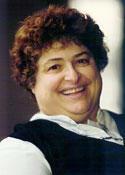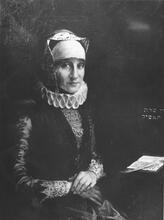Helene, Queen of Adiabene
Sarcophagus of Helene, Queen of Adiabene, from a collection at the Louvre Museum. Image via WIkimedia Commons.
Helene was the sister and wife of Monabazus Bazaeus, king of Adiabene at the beginning of the first century CE. Her story is recorded in both Josephus’ Antiquities and rabbinic literature, who both record that she converted to Judaism along with her family. After her death, Josephus records that she was buried in Jerusalem. Her tomb was discovered in the nineteenth century and can be visited today.
Article
Helene was the sister and wife of Monabazus Bazaeus, king of Adiabene at the beginning of the first century CE, who converted to Judaism with other members of her family. Adiabene, a Persian province on the northern extremities of the Tigris River, was at the time a vassal kingdom of the Parthian Empire.
Helene in Josephus
The main source of information about Helene is from Josephus’ Antiquities (20:17–96). In his rather romantic narrative, Helene is described as the mother of a god-chosen younger son, Izates. She protected him from his older, jealous brothers (her own sons and those of other wives) by sending him into the custody of a king in Charax Spasinu. During her son’s absence, a sage named Hananiah drew her to the teachings of Judaism. Coincidentally another Jewish sage, Eleazar, influenced Izates in the same way. They both converted. At a later stage Helene’s elder son, Monobazus, who eventually inherited Izates’s kingdom, followed their example and similarly embraced Judaism.
Helene played an important role in the succession of her son, summoning the nobles of the kingdom and informing them that it had been her husband’s wish to nominate Izates king. Declining their advice to put Izates’s brothers to death in order to avoid plots against him, she instead placed her elder son, Monobazus, as guardian of the country until the return of the heir. Josephus lauds her for all these sage decisions.
Josephus further relates Helene’s pilgrimage to Jerusalem in 46–47 CE. Confronted with a famine in the city, she is reputed to have assisted the Jews of Jerusalem by buying grain and dried figs in Egypt and importing them into the country in large quantities. According to Josephus, her beneficial acts of patronage were warmly welcomed. Finally, we are informed that on Izates’s death in 55 CE, she returned to Adiabene to see her elder son Monobazus crowned king. She died shortly thereafter. The bodies of both Helene and Izates were then transferred to Jerusalem and buried in the royal sepulchre she had built while in the city. Most of Josephus’s narrative is devoted to Izates’s reign and his exploits and successes. Obviously it is drawn from this king’s royal chronicle.
Helene in Rabbinic Literature
Rabbinic literature also refers to Queen Helene, showing far more interest in her than in any other member of the family. In three separate episodes, the rabbis inform us that (1) Helene donated a golden lamp to the Temple, as well as a golden plaque on which was engraved the biblical episode of the wayward wife (the Suspected adulteresssotah, Codification of basic Jewish Oral Law; edited and arranged by R. Judah ha-Nasi c. 200 C.E.Mishnah The Day of Atonement, which falls on the 10th day of the Hebrew month of Tishrei and is devoted to prayer and fasting.Yoma 3:10); (2) Helene made a Nazirite; person who vows to abstain for a specific period (or for life) from grape and grape products, cutting his hair, and touching a corpse.nazirite vow, to which she adhered—perhaps in accordance with Bet Shammai—for fourteen years (Mishnah Nazir 3:6); (3) Helene resided in a grand Booth erected for residence during the holiday of Sukkot.sukkah, over 20 cubits high, which the rabbis frequented (BT Sukkah 2:2). It also relates that Helene was the mother of Monobazus (Mishnah Yoma 3:10) but makes no mention of her relationship to Izates. The A type of non-halakhic literary activitiy of the Rabbis for interpreting non-legal material according to special principles of interpretation (hermeneutical rules).midrash Genesis Rabbah speaks of the conversion of two kings—Monbaz and Zoitos—but seems not to connect them to Helene (Genesis Rabbah 46:11). All this suggests that, unlike Josephus, who used the Adiabenese royal chronicle and was interested in kings, the rabbis had been impressed by the queen, her piety, and her benefaction. Their sympathetic portrayal of her may suggest that her conversion was to the Pharisee/rabbinic variety of Judaism.
Archaeology
Helene’s royal sepulchre was the subject of both enthusiastic literary descriptions and archaeological investigations. Josephus tells us that Helene in her lifetime built pyramids over the intended tomb. Pausanias, in his Description of Greece (7, 16, 5), mentions a unique mechanism that opened the tomb automatically at certain times and sealed it at others. This tomb was discovered by the French archaeologist Louis Félicien Caignart de Saulcy (1807–1880), who conducted the first systematic archaeological dig in Jerusalem in the middle of the nineteenth century. It is a magnificent structure that can still be visited today. A sarcophagus discovered in the sepulchre bore the inscription צדן מלכתא—Queen Sadan. From this, we may infer that the queen’s Persian name was Sadan, while Helene was her Greek name.
Gafni, Isaiah. “The Conversion of the Adiabene Kings in Light of Talmudic
Literature” (Hebrew). Niv
Hamidrashia (1971): 204–212.
This article describes the sources on the conversion of the royal house of
Adiabene in light of halakhic rulings and rabbinic references to the royal
house.
Ilan, Tal. Integrating
Women into Second Temple History. Tübingen: 1999.
In these two chapters, Ilan argues that Helene was converted to a Pharisee
variety of Judaism. She further argues that she was a follower of the school
of Bet Shammai.
Schalit, Abraham. “Evidence of an Aramaic Source in Josephus’s Antiquities
of the Jews.” Annual
of the Swedish Theological Institute 4 (1975): 171–181.
In this article Schalit links the story of the Adiabenese royal conversion
with another story about Babylonian Jews found in Josephus Antiquities,
vol. 20. He claims the source was in Aramaic and circulated in the eastern
Diaspora. Schalit maintains that the story of Helene and Izates was part of
a royal chronicle.
Schick, Conrad “The (So-Called) Tombs of the Kings at Jerusalem” PEFQS
29 (1897): 182–88.
This report is a fair description of the Helene’s burial estate with a correct
identification of the tomb as that of the royal Adiabenese household.
Schiffman, Lawrence H. “The Conversion of the Royal House of Adiabene in Josephus
and Rabbinic Sources.” In Josephus,
Judaism and Christianity, edited by L. H. Feldman and G. Hata, 293–312.
Detroit: 1987.
This article deals with the story of the conversion of Izates and Monobazus
as it is recorded in Genesis
Rabbah. It demonstrates well that the rabbis did not connect this story
with Helene, whom they knew from elsewhere, and that they were not aware that
she was a convert.












